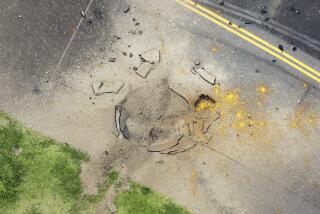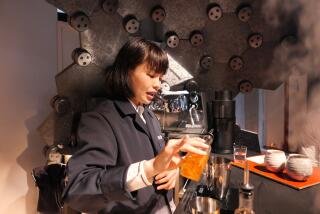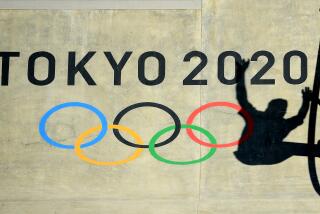The Pacific : Airport Expected to Help Region Take Off : Japan: New Osaka facility is key to a strategy to make the area a center for Asian business.
- Share via
OSAKA, Japan — It is the most expensive airport ever built--50% over budget when all was said and done.
It has overcome serious engineering problems--namely the instability of the ground of the artificial island three miles offshore in Osaka Bay on which it rests.
When it opens on Sunday, the owner of the new $15-billion Kansai International Airport will be facing interest payments of $580 million a year and operating deficits for years to come.
But the huge project will be enthusiastically welcomed by this city--Japan’s second largest--which sees the airport as key to its bid to become a major Pacific Rim transportation hub. The airport also is the centerpiece in a broad effort to boost the economy of the Osaka area and make it a regional center for Asian business.
The six-prefecture area known as Kansai--which in addition to Osaka includes the ancient capital of Kyoto and the internationally flavored port city of Kobe--has a population of 20 million. With an annual output of $800 billion, Kansai’s economic power exceeds that of Canada.
Yet until now, Kansai has had only one airport of any significance: the relatively small Itami airport in Osaka. Even worse, Itami has had rather few international connections and flights are banned after 9 p.m. because of the number of homes nearby.
Thus the new airport--Japan’s first 24-hour facility--aims to unleash the power of this region by ending its relative isolation.
It was designed by Italian architect Renzo Piano as a modernistic reflection of old European arch-roofed train terminals. But it has been plagued by major setbacks, the most serious being unexpectedly severe--and uneven--subsidence of the man-made island, which is still sinking at the rate of more than an inch per month. Buildings had to be built on jacks to keep them level, and the runway is asphalt for easy repaving.
But local people say they are confident that in the long run, the facility will prove its worth.
“If you think about the 21st Century, it’s a huge plus,” said Sachiko Yoshimi, 55, who works for a garment wholesaler. “It’s absolutely necessary in order for Osaka to be able to grow.”
The airport is the core effort among 866 large-scale urban development projects underway in the region, at a total cost of more than $410 billion. These range from the recently opened Asia and Pacific Trade Center, a waterfront complex focused on retailing and wholesaling of imported consumer goods, to an expanding set of research institutes collectively known as Kansai Science City.
These projects are partly intended to ease the over-centralization in Tokyo of Japanese economic life, a situation that creates a variety of anomalies and inefficiencies.
Publishing, as just one example, is so heavily concentrated in the capital that national distribution networks radiate only from there. Cazi Cazi, a young men’s fashion magazine published in Osaka that has most of its circulation in the Kansai region, must ship its entire press run to Tokyo. There, it is loaded on trucks along with other publications and sent back to Kansai for distribution to retail outlets. Cazi Cazi Editor Kazuyuki Hamahata expressed hope that the new airport will stimulate enough economic growth and improvement of local distribution networks to eventually change this situation.
Local officials are already using the new airport to promote the idea of Osaka as an international base for business activities in East Asia.
Osaka businesses have traditionally had close ties with Seoul, South Korea, and Taipei, Taiwan. Kansai-based industries have also played a major role in Japan’s accelerating transfer of manufacturing to Southeast Asia and China--a trend encouraged by the yen’s recent strengthening against the dollar, which makes it cheaper to manufacture goods abroad. Travel to any of these Asian places will be significantly quicker and easier from Osaka than from Tokyo.
“We would like global enterprises to put their Asian strategic headquarters here, and we hope that Asian companies will put their bases in Osaka for expanding globally,” said Kenichi Nagata, chief planner for the Osaka city government. “Many headquarters are located in Tokyo or Hong Kong for those purposes, but we hope to attract them here.”
Nagata cited a survey showing that Tokyo still has a big edge in terms of business opportunities but that Osaka comes out ahead in other factors also important to companies--particularly the cost of office space and the quality of life for employees. Statistics collected by the Osaka city government show office space costs average about 80% higher in Tokyo.
Companies from Taiwan have so far taken the largest number of wholesale spots at the Asia and Pacific Trade Center, where they market home electronics, jewelry and clothing.
The airport belongs to a public-private consortium created by various local governments and more than 1,000 private companies, in addition to the national government for the purpose of bringing the region a first-class airport. It is expected at first to handle about 50 international and 70 domestic flights a day.
With heavy interest payments on construction loans, the airport will run a huge deficits for at least the next few years, despite landing fees matching those at Tokyo as the highest in the world.
Times researcher Chiaki Kitada in Tokyo contributed to this story.
More to Read
Sign up for The Wild
We’ll help you find the best places to hike, bike and run, as well as the perfect silent spots for meditation and yoga.
You may occasionally receive promotional content from the Los Angeles Times.






